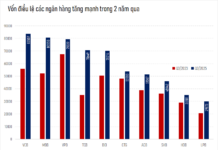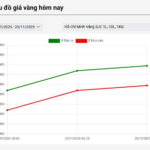As the Vietnamese government aims to reach one million private enterprises by 2030, a critical question arises: How can Vietnam’s 5,400 traditional craft villages not only survive but also become drivers of sustainable economic growth? Esteemed artisan Vũ Mạnh Hải, Chairman of Bảo Tín Mạnh Hải Jewelry Company, shared invaluable insights during the “Building the Nation – Vietnamese Pride” talk show on transforming cultural heritage into a competitive market advantage.
Drawing from his entrepreneurial journey, which began within his family and evolved into a structured business model, Hải emphasizes that traditional crafts are more than livelihoods—they are guardians of the nation’s cultural essence. Modernization need not erase identity; instead, it is this very identity that fosters the uniqueness modern businesses strive for.
Cultural Preservation: The Foundation for Growth
Hải identifies cultural authenticity as the cornerstone for sustainable craft enterprises. He cites Bát Tràng Pottery Village, where ancient techniques and traditional glazes like cobalt blue and eel skin are preserved, as a prime example. In jewelry, while advanced technology shapes gold products, designs rooted in Vietnamese culture—such as Khuê Văn Pavilion, Lý Dynasty dragons, and lotus motifs—elevate both material and cultural value.

However, preservation alone is insufficient. Traditional crafts must adopt business acumen—clear processes, consistent quality, market focus, and digital integration. Hải’s company exemplifies this by introducing certified gold bullion bars, blending investment value with cultural symbolism through Vietnamese motifs.
Collaboration is key. Craft villages must partner with designers, brand experts, digital platforms, and global markets. By engaging young art school graduates, Hải’s team creates contemporary designs. Expanding distribution via social media and e-commerce has significantly boosted sales.
Empowering Craft Villages as National Economic Drivers
To contribute to the one-million-enterprise goal, Hải proposes leveraging the 5,000+ craft villages through a five-pillar strategy: Positioning crafts as a cultural-economic sector with targeted capital and training policies; establishing creative hubs in key regions; comprehensive digitalization (e-commerce, traceability); building a “Made in Vietnam” brand akin to Italy or Japan; and developing specialized supply chains.
Digital tools, such as electronic tags on jewelry, enable instant product tracking—from warehouse to sale date—streamlining inventory management and enhancing customer service.
Competitiveness, Hải notes, requires more than quality. Brands must embody cultural narratives, resonating emotionally with modern Vietnamese consumers. Many businesses excel in craftsmanship but fall short in brand storytelling, which demands deep cultural understanding and digital engagement, especially with youth.
Elevating Craft Villages’ Value
As Chairman of the Artisans Association, Hải advocates three culture-centric initiatives. First, integrate crafts with experiential tourism, positioning artisans as cultural ambassadors. Well-structured, this could employ millions in rural areas and boost tourism.
He envisions craft clusters where visitors participate in production—molding clay, dyeing fabric—fostering appreciation and premium pricing. Destinations like Bát Tràng (ceramics), Huế (conical hats), and Hội An (woodcraft) could offer immersive heritage experiences. Training artisans as storytellers would deepen visitor connections.

Hải’s journey underscores that culture, when strategically harnessed, fuels economic development. Products must embody cultural value and compelling narratives to thrive. By embedding heritage into innovation, Vietnamese brands can compete globally while preserving traditions—a dual victory for cultural conservation and national progress.
Sóc Sơn: The Aspiration to Become the Sustainable Northern Metropolis of the Capital
The Soc Son District Party Committee’s resolution envisions a breakthrough development by 2045, with a fresh perspective and approach, aiming to establish itself as a sustainable northern urban area of Hanoi. To achieve this ambitious goal, Soc Son will leverage its strengths and focus on economic restructuring and tourism promotion, setting a new course for its future.
A Transformational Vision for Gia Lai’s Agriculture: Unlocking its Potential with Pioneer Investments
With over 33,000 billion VND in investment for large-scale agricultural projects, Gia Lai is poised to become a powerhouse of high-tech agriculture. This significant investment is expected to act as a catalyst, elevating Gia Lai to a prominent position as a regional leader in agricultural produce with top-tier brands.
The 2024 Total Budget Revenue Surpasses Projections by 17.4%
The year 2024 marked the relentless efforts of the Ministry of Finance in executing the nation’s financial and budgetary tasks. With agile and assertive fiscal policies, the ministry’s revenue and expenditure achievements yielded commendable outcomes, making significant contributions to macroeconomic stability, inflation control, and social welfare assurance.
The Haunting of the ‘House of Mr. Phu’: A Tale of a Historic Mansion
The Dong Nai Provincial Party Committee has decided to preserve the “Nha Lau Ong Phu” villa to uphold its cultural, historical, and architectural significance. This decision underscores the importance of safeguarding our heritage and ensuring that these treasures are accessible for future generations to appreciate and enjoy.










































